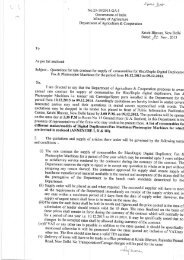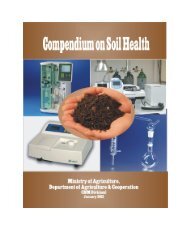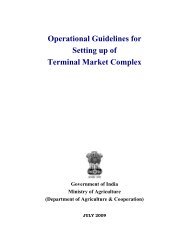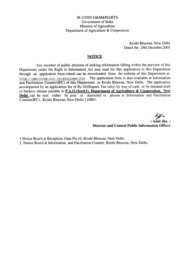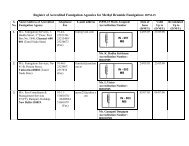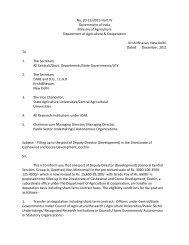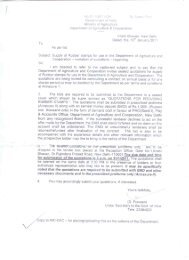Annual Report 2009-2010 - Department of Agriculture & Co-operation
Annual Report 2009-2010 - Department of Agriculture & Co-operation
Annual Report 2009-2010 - Department of Agriculture & Co-operation
You also want an ePaper? Increase the reach of your titles
YUMPU automatically turns print PDFs into web optimized ePapers that Google loves.
<strong>Annual</strong> <strong>Report</strong> <strong>2009</strong>-<strong>2010</strong><br />
50<br />
9<br />
Agricultural Extension<br />
9.1 Support to State Extension Programmes<br />
for Extension Reforms: This scheme <strong>of</strong> Support<br />
to State Extension Programmes for Extension<br />
reforms, launched during 2005-06, aims at<br />
making the extension system farmer-driven and<br />
farmer-accountable, by way <strong>of</strong> new institutional<br />
arrangements for technology dissemination in<br />
the form <strong>of</strong> an Agricultural Technology<br />
Management Agency (ATMA) at the district level<br />
to <strong>operation</strong>alise extension reforms. ATMA has<br />
the active participation <strong>of</strong> farmers and farmer<br />
groups, NGOs, Krishi Vigyan Kendras, Panchayati<br />
Raj institutions, and other stakeholders operating<br />
at the district level and below. The release <strong>of</strong><br />
funds under the ATMA scheme is based on State<br />
Extension Work Plans (SEWPs) prepared by the<br />
state governments. At present, the scheme is<br />
under implementation in 588 districts in 29<br />
states/UTs in the country.<br />
9.2 In line with the provisions <strong>of</strong> the National<br />
Policy for Farmers, which has been formulated as<br />
per the reports and recommendations <strong>of</strong> the<br />
National <strong>Co</strong>mmission on Farmers, the existing<br />
provisions and implementation mechanisms have<br />
been strengthened. The cafeteria <strong>of</strong> activities<br />
being supported under the scheme has state as<br />
well as district-level activities. State-level activities<br />
include support for upgrading State-Level Training<br />
Institutions (SAMETI), training and exposure visits<br />
<strong>of</strong> extension functionaries, organisation <strong>of</strong> statelevel<br />
agricultural exhibitions, regional fairs and<br />
exhibitions, monitoring and evaluation, rewards<br />
and incentives. District-level activities include<br />
farmer-oriented activities (training, demonstration,<br />
exposure visits, group mobilisation, and capacity<br />
building), farm information dissemination activities<br />
(exhibition, information technology, print media),<br />
and research-extension-farmer linkages, (farmer<br />
scientist interactions, organisation <strong>of</strong> field days<br />
and kisan goshties; assessment, refinement,<br />
validation, and adoption <strong>of</strong> front line technologies).<br />
9.3 The important features <strong>of</strong> the cafeteria<br />
include:<br />
Farm schools in the fields <strong>of</strong> outstanding<br />
farmers being promoted at the block/gram<br />
panchayat level by integrating progressive<br />
farmers into the Agricultural Extension<br />
System (AES) (a minimum <strong>of</strong> one farm<br />
school/block).



